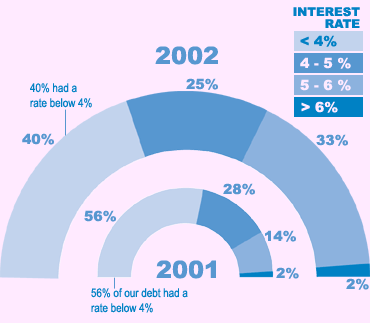 |
De-pend-able adj [from Latin de-
+ pendere to hang from] 1: suitable or fit to be
relied on 2: just another way to say the United Stated
Postal Service.


Our interest expense is determined by the interaction of
a number of variables including day-to-day cash flows, the behavior of
interest rates and our debt management activities.
We prefer to maintain a mix of fixed- and floating-rate debt because we
believe that, over the long term, variable- or floating-rate debt may
provide more cost-effective financing than 100% fixed-rate debt. However,
we strive for a favorable balance, and we borrow fixed-rate debt when
market opportunities arise, or when we believe doing so reduces risk.
Such was the case this year with long-term interest rates declining to
historically low levels not seen in 40 years. We shifted the balance of
our debt portfolio toward more fixed-rate long-term debt, reducing our
exposure to any increase in interest rates.
We entered 2002 knowing that $1.15 billion of our long-term debt would
become reclassified as short-term debt by the end of the year. We also
believed that long-term rates had become very attractive for borrowers.
Rather than execute all of our transactions at one time, we prefer to
assess market conditions continuously and then make measured increments
in our borrowing. Beginning in February, and then again in July and September,
we added $2.7 billion in long-term debt in eleven separate transactions.
The weighted average rate on this year’s financings was 4.36%, and the
weighted average maturity was 10.49 years. We benefited from declining
rates by stabilizing future interest expense volatility.
At year-end, our long-term debt was $7.3 billion, with a weighted average
interest rate of 5.01%, in comparison with $5.75 billion and a weighted
average rate of 5.17% at the end of 2001. Our 2002 borrowing transactions
ranged from a high of 5.522% for a twenty-nine-year maturity to a low
of 3.449% for a five-year maturity. As we enter 2003, our debt portfolio
puts us in a good position to manage interest expense and risk for next
year and beyond. 

|
 |
AT THE END OF 2002,
ONLY $250 MILLION OR 2% OF OUR DEBT HAD A RATE ABOVE 6%.

AT YEAR-END 2002,
$2.7 BILLION OF OUR
DEBT HAD AN INTEREST
RATE BELOW 2%.
|
|






